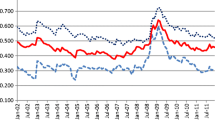Abstract
Linear models are typically used in the regression analysis of capital structure choices. However, given the proportional and the bounded nature of leverage ratios, models such as the tobit, the fractional regression model and its two-part variant are a better alternative. In this article, we discuss the main econometric assumptions and features of those models, provide a theoretical foundation for their use in the regression analysis of leverage ratios and review some statistical tests suitable to assess their specification. Using a dataset previously considered in the literature, we carry out a comprehensive comparison of the alternative models, finding that in this framework the most relevant functional form issue is the choice between a single model for all capital structure decisions and a two-part model that explains separately the decisions to issue debt and, conditional on the first decision, on the amount of debt to issue.
Similar content being viewed by others
References
Baker M, Wurgler J (2002) Market timing and capital structure. J Financ 57(1): 1–32
Bessler W, Drobetz W, Haller R, Meier I (2011) Financial constraints and the international zero-leverage phenomenon. mimeo
Byoun S (2008) How and when do firms adjust their capital structures toward targets?. J Financ 63(6): 3069–3096
Byoun S, Moore WT, Xu Z (2008) Why do some firms become debt-free? mimeo
Cameron AC, Trivedi PK (2005) Microeconometrics—methods and applications. Cambridge University Press, Cambridge
Cassar G (2004) The financing of business start-ups. J Bus Ventur 19: 261–283
Cook DO, Kieschnick R, McCullough BD (2008) Regression analysis of proportions in finance with self selection. J Empir Financ 15(5): 860–867
Dang VA (2011) An empirical analysis of zero-leverage firms: evidence from the UK. mimeo
Davidson R, MacKinnon JG (1981) Several tests for model specification in the presence of alternative hypotheses. Econometrica 49(3): 781–793
Fama E, French K (2001) Disappearing dividends: changing firm characteristics or lower propensity to pay?. J Financ Econ 60: 3–43
Faulkender M, Petersen MA (2006) Does the source of capital affect capital structure?. Rev Financ Stud 19(1): 45–79
Fattouh B, Harris L, Scaramozzino P (2008) Non-linearity in the determinants of capital structure: evidence from UK firms. Empir Econ 34: 417–438
Ferreira D, Ferreira M, Raposo F (2011) Board structure and price informativeness. J Financ Econ 99(3): 523–545
Frank MZ, Goyal VK (2008) Tradeoff and pecking order theories of debt. In: Eckbo BE (ed) Handbook of corporate finance—empirical corporate finance. Elsevier, Amsterdam, pp 135–202
Gompers P, Metrick A (2001) Institutional investors and equity prices. Q J Econ 116(1): 229–259
Heckman JJ (1979) Sample selection bias as a specification error. Econ Theory 47(1): 153–161
Jensen G, Solberg D, Zorn T (1992) Simultaneous determination of insider ownership, debt, and dividend policies. J Financ Quant Anal 27(2): 247–263
Johnson SA (1997) An empirical analysis of the determinants of corporate debt ownership structure. J Financ Quant Anal 32(1): 47–69
John K, Knyazeva A, Knyazeva D (2011) Does geography matter? Firm location and corporate payout policy. J Financ Econ 101(3): 533–551
Kurshev A, Strebulaev IA (2007) Firm size and capital structure. mimeo
Lemmon ML, Roberts MR, Zender JF (2008) Back to the beginning: persistence and the cross-section of corporate capital structure. J Financ 63(4): 1575–1608
Leung SF, Yu S (1996) On the choice between sample selection and two-part models. J Econ 72: 197–229
McDonald JF, Moffitt RA (1980) The uses of tobit analysis. Rev Econ Stat 62(2): 318–321
Opler T, Pinkowitz L, Stulz R, Williamson R (1999) The determinants and implications of corporate cash holdings. J Financ Econ 52(1): 3–46
Papke LE, Wooldridge JM (1996) Econometric methods for fractional response variables with an application to 401(k) plan participation rates. J Appl Econ 11(6): 619–632
Prasade S, Green CJ, Murinde V (2005) Company financial structure: a survey and implications for developing economies. In: Green CJ, Kirkpatrick CH, Murinde V (eds) Finance and development: surveys of theory, evidence and policy. Edward Elgar, Cheltenham, pp 356–429
Rajan RJ, Zingales L (1995) What do we know about capital structure? Some evidence from international data. J Financ 50(5): 1421–1460
Ramalho JJS, Silva JV (2009) A two-part fractional regression model for the financial leverage decisions of micro, small, medium and large firms. Quant Financ 9(5): 621–636
Ramalho EA, Ramalho JJS, Henriques P (2010) Fractional regression models for second stage DEA efficiency analyses. J Produc Anal 34(3): 239–255
Ramalho EA, Ramalho JJS, Murteira J (2011) Alternative estimating and testing empirical strategies for fractional regression models. J Econ Surveys 25(1): 19–68
Santos Silva JMC, Tenreyro S (2006) The log of gravity. Rev Econ Stat 88(4): 641–658
Strebulaev IA, Yang B (2007) The mystery of zero-leverage firms. mimeo.
Wald JK (1999) How firm characteristics affect capital structure: an international comparison. J Financ Res 22(2): 161–187
Wooldridge JM (2002) Econometric analysis of cross section and panel data. The MIT Press, Cambridge
Author information
Authors and Affiliations
Corresponding author
Rights and permissions
About this article
Cite this article
Ramalho, J.J.S., da Silva, J.V. Functional form issues in the regression analysis of financial leverage ratios. Empir Econ 44, 799–831 (2013). https://doi.org/10.1007/s00181-012-0564-6
Received:
Accepted:
Published:
Issue Date:
DOI: https://doi.org/10.1007/s00181-012-0564-6




